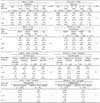Abstract
The objective of the current study was to examine associations of whole grain consumption with socio-demographic (i.e.: sex, age, household income, education, marriage status) and certain eating behavior factors (i.e.: dish source, eating place, meal type) among a generally healthy Korean population. Using twenty-four hour recall data from the 2007-2008 National Health and Nutrition Examination Surveys, whole grain intake (g/day) was calculated for a total of 8,836 generally healthy Koreans aged 6 years and higher. The study subjects had very low whole grain intake. Specifically approximately 60% of the subjects reported no whole grain consumption on the survey day, and mean daily intake ranged from 8.0 g to 15.1 g in different gender and age groups. Living with a spouse was found to be a positive environment factor for whole grain consumption, especially among men. As household income levels increased, whole grain consumption status also improved. The proportion of non-consumer was lowest in a 6-19 year group, and mean intake amount was highest in middle-aged adults. Major dish sources for whole grain consumption included boiled rice with mixed grains, corn, boiled rice with brown rice, cereal products, and other types of boiled rice. It was found that whole grain consumption was highly affected by eating places rather than meal types. The best contributing eating place was home in each age and gender group. The study findings may be useful in planning nutrition education strategy and formulating dietary behavior guidelines for whole grain consumption improvement.
Figures and Tables
Table 2
Mean whole grain intake (g/day) by socio-demographic factors

1) NS: not significant, *: p < 0.05, **: p < 0.01 by ANOVA or t test for difference between socio-demographic status within gender
2) NS: not significant, *: p < 0.05, **: p < 0.01 by t test for difference between gender within a row
3) Different letters represent statistical difference by Duncanís multiple comparison test
References
1. Anderson JW, Hanna TJ, Peng X, Kryscio RJ. Whole grain foods and heart disease risk. J Am Coll Nutr. 2000. 19:3 Suppl. 291S–299S.
2. Albertson AM, Tobelmann RC. Consumption of grain and whole grain foods by an American population during the years 1990-92. J Am Diet Assoc. 1995. 95(6):703–704.
3. Bakke A, Vickers Z. Consumer liking of refined and whole wheat breads. J Food Sci. 2007. 72(7):S473–S480.
4. Burgess-Champoux TL, Rosen R, Marguart L, Reicks M. The development of psychosocial measures for whole-grain intakeamong children and their parents. J Am Diet Assoc. 2008. 108(4):714–717.
5. Chase K, Reicks M, Jones JM. Applying the theory of planned behavior to promotion of whole-grain foods by dietitians. J Am Diet Assoc. 2003. 103(12):1639–1642.
6. Chase K, Reicks M, Smith C, Henry H, Reimer K. Use of the think-aloud method to identify factors influencing purchase of bread and cereals by low-income African American women and implications for whole-grain education. J Am Diet Assoc. 2003. 103(4):501–504.
7. Cleveland LE, Moshfegh AJ, Albertson AM, Goldman JD. Dietary intake of whole grains. J Am Coll Nutr. 2000. 19:3 Suppl. 331S–338S.
8. de Munter JS, Hu FB, Spiegelman D, Franz M, van Dam RM. Whole grain, bran, and germ intake and risk of type 2 diabetes: a prospective cohort study and systematic review. PLoS Med. 2007. 4(8):e261.
9. Flint AJ, Hu FB, Glynn RJ, Jensen MK, Franz M, Sampson L, Rimm EB. Whole grains and incident hypertension in men. Am J Clin Nutr. 2009. 90(3):493–498.
10. Fung TT, Hu FB, Pereira MA, Liu S, Stampfer MJ, Colditz GA, Willett WC. Whole-grain intake and the risk of type 2diabetes: a prospective study in men. Am J Clin Nutr. 2002. 76(3):535–540.
11. Gellar L, Rovner AJ, Nansel TR. Whole grain and legume acceptability among youths with type 1 diabetes. Diabetes Educ. 2009. 35(3):422–427.
12. Jacobs DR Jr, Marquart L, Slavin J, Kushi LH. Whole-grain intake and cancer: an expanded review and meta analysis. Nutr Cancer. 1998. 30(2):85–96.
13. Jones JM, Reicks M, Adams J, Fulcher G, Weaver G, Kanter M, Marquart L. The importance of promoting a whole grain food message. J Am Coll Nutr. 2002. 21(4):293–297.
14. Lacey JM. Enhancing students' understanding of whole cereal grains in a university experimental foods course. J Nutr Educ Behav. 2007. 39(4):235–236.
15. Liu S, Stampfer MJ, Hu FB, Giovannucci E, Rimm E, Manson JE, Hennekens CH, Willett WC. Whole-grain consumption and risk of coronary heart disease: result from the Nurses Health Study. Am J Clin Nutr. 1999. 70(3):412–429.
16. Marquart L, Pham AT, Lautenschlager L, Croy M, Sobal J. Beliefs about whole-grain foods by food and nutrition professionals, health club members, and special supplemental nutrition program for women, infants, and children participants/state fair attendees. J Am Diet Assoc. 2006. 106(11):1856–1860.
17. Meyer KA, Kushi LH, Jacobs DR Jr, Slavin J, Sellers TA, Folsom AR. Carbohydrates, dietary fiber, and incident type 2 diabetes in older women. Am J Clin Nutr. 2000. 71(4):921–930.
18. Content of Korea National Health & Nutrition Examination Survey. Ministry for Health, Welfare and Family Affairs & Center for Disease Control and Prevention. 2011. cited 2011 April 20. Available from
http://knhanes.cdc.go.kr/.
19. Montonen J, Knekt P, järvinen R, Aromaa A, Reunanen A. Whole grain and fiber intake and the incidence of type 2 diabetes. Am J Clin Nutr. 2003. 77(3):622–629.
20. O'Neil CE, Nicklas TA, Zänovec M, Cho S. Whole-grain consumption is associated with diet quality and nutrient intake in adults: the National Health and Nutrition Examination Survey, 1999-2004. J Am Diet Assoc. 2010. 110(10):1461–1468.
21. Eating well with Canada's food guide. The Minister of Health Canada. 2007. cited 2009 September 25. Available from
http://www.hc-sc.gc.ca/fn-an/food-guide-aliment/index-eng.php.
22. The eatwell plate. U.K. Food Standards Agency. 2007. cited 2009 September 25. Available from
http://www.eatwell.gov.uk/healthydiet/eatwellplate.
23. U.S. Department of Health and Human Services & U.S. Department of Agriculture. Dietary guidelines for American. 2005. 6th ed. Washington, DC: Government Printing Office;52–55.




 PDF
PDF ePub
ePub Citation
Citation Print
Print






 XML Download
XML Download